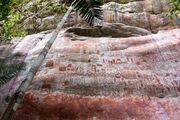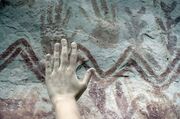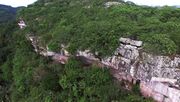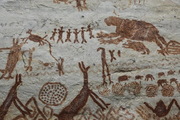سرانيا دلا لندوسا
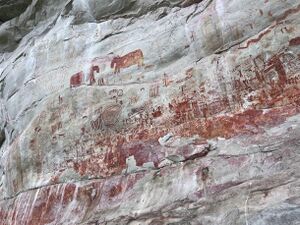 | |
| المكان | Serranía de la Lindosa, Guaviare Department, Colombia |
|---|---|
| المنطقة | Amazon Rainforest |
| الطول | About 13 km (8 mi) |
| التاريخ | |
| هـُـجـِر | Yes |
| الفترات | Contested, see text |
| ملاحظات حول الموقع | |
| اكتـُشـِف | 19th century |
| الأثريون | Ella Al-Shamahi |
| الملكية | Government of Colombia |
| الاتاحة للعامة | Limited |
The Serranía de la Lindosa is a 13 km (8 mi) stretch of cliff in Colombia covered by tens of thousands of painted rock art images.
الاكتشاف
The rock art was first recorded in the 19th century by Agustin Codazzi, who was mapping the region. It was also recorded by Richard Evans Schultes in 1943. The first photographs were taken in the 1980s.[1] Some sources erroneously suggest that the site was only recently discovered when it was publicized in the 2020s.
المواعدة
The murals have not been directly dated. Some authors have suggested that they date to around 12,600 years ago, based on dating of sediment layers containing ochre flakes within excavations near the art,[2][3] but others suggest that they are too well preserved to be so old.[4][5] Local interpretative guides at the Cerro Azul site within Serranía De La Lindosa have said that the ochre paste was mixed with tree saps to aid in its preservation.[3] It has been alternatively proposed that the art was made in the last 500 years by indigenous peoples after the initial European discovery of the Americas.[1][6]
جداريات
The murals were painted with yellow and red ochre.[7][3] Some paintings at the Cerro Azul and Nuevo Tolima sites show figures climbing ladders or palm trees, indicating how they were able to reach the high upper painted walls.[3] Some authors claim that the art depicts now-extinct South American megafauna, such as ground sloths, gomphotheres, native equines (Hippidion) and macraucheniids;[2] others argue that they likely represent living animals, including domestic species introduced in the Columbian exchange like horses and cows, leading to a younger age estimate.[5][1][6][3]
- تحكي لوحات جدارية صخرية عمرها حوالي ١٢٥٠٠ عام عن فيضان قديم عندما ارتفع منسوب المياه ونفقت الحيوانات. لا يزال هناك الكثير من الاكتشافات في أدغال أمريكا الجنوبية.
المصادر
- ^ أ ب ت "This Amazon Rock Art Is 12,600 Years Old And Depicts Extinct Creatures". Discover Magazine (in الإنجليزية). Retrieved 2024-03-03.
- ^ أ ب Iriarte, José; Ziegler, Michael J.; Outram, Alan K.; Robinson, Mark; Roberts, Patrick; Aceituno, Francisco J.; Morcote-Ríos, Gaspar; Keesey, T. Michael (2022-04-25). "Ice Age megafauna rock art in the Colombian Amazon?". Philosophical Transactions of the Royal Society B: Biological Sciences (in الإنجليزية). 377 (1849). doi:10.1098/rstb.2020.0496. ISSN 0962-8436. PMC 8899627. PMID 35249392.
- ^ أ ب ت ث ج Trupp, Tony (June 15, 2022). "The Rock Art of Serranía De La Lindosa". Earth As We Know It. Retrieved November 20, 2024.
- ^ ancientartarch (2022-03-08). "Are these pictographs 12,000 years old?". Ancient Art Archive (in الإنجليزية الأمريكية). Retrieved 2024-03-03.
- ^ أ ب Hunt, Katie (2022-03-07). "Controversial rock art may depict extinct giants of the ice age". CNN (in الإنجليزية). Retrieved 2024-03-03.
- ^ أ ب Ferreira, Becky (2022-03-07). "Does This Amazon Rock Art Depict Extinct Ice Age Mammals?". The New York Times (in الإنجليزية الأمريكية). ISSN 0362-4331. Retrieved 2024-03-03.
- ^ Kelleher, Suzanne Rowan (December 3, 2020). "Photos: 'Sistine Chapel Of The Ancients' Cliff Drawings Revealed In Colombia". Forbes. Retrieved January 11, 2021.

